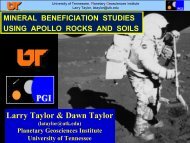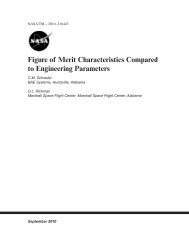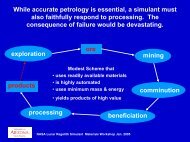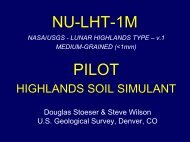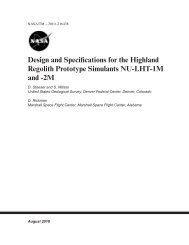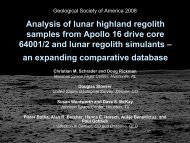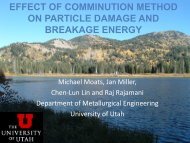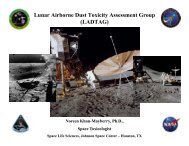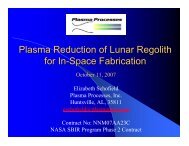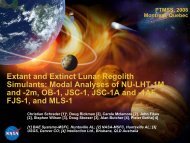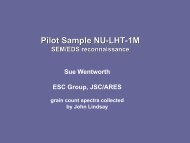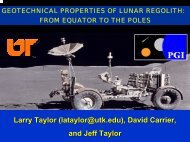Book of Abstracts- Lunar Regolith Simulant Materials Workshop
Book of Abstracts- Lunar Regolith Simulant Materials Workshop
Book of Abstracts- Lunar Regolith Simulant Materials Workshop
Create successful ePaper yourself
Turn your PDF publications into a flip-book with our unique Google optimized e-Paper software.
COMPOSITION OF THE LUNAR HIGHLAND CRUST: A NEW MODEL. Paul D. Lowman Jr., Goddard<br />
Space Flight Center (Code 921) Greenbelt, MD 20771, Paul.D.Lowman@nasa.gov<br />
Introduction: This paper presents a synthesis <strong>of</strong><br />
Apollo remote sensing data, Earth-based reflectance<br />
spectroscopy, returned sample analyses, and Apollo<br />
EVA photographs, pointing to a new model for the<br />
composition and origin <strong>of</strong> the oldest lunar highland<br />
crust. The petrology <strong>of</strong> the lunar highlands has been a<br />
difficult problem because <strong>of</strong> the deep and apparently<br />
continuous regolith mantle, a mixture <strong>of</strong> breccias, impact<br />
melts, and exotic rock fragments. However, a reexamination<br />
<strong>of</strong> EVA photographs <strong>of</strong> highland structure<br />
taken on the Apollo 15, 16, and 17 missions reveals<br />
pervasive layering similar to terrestrial lava flows such<br />
as those <strong>of</strong> the Columbia Plateau. X-ray fluorescence<br />
surveys point to a high-alumina basaltic composition<br />
for the highland crust, an interpretation consistent with<br />
earth-based reflectance spectroscopy and analyses <strong>of</strong><br />
returned highland samples, especially from Apollo 17.<br />
It is concluded that the highland crust is largely highalumina<br />
hypersthene basalt, formed by global fissure<br />
eruptions during the first few hundred million years <strong>of</strong><br />
the Moon’s existence. Anorthosites, troctolites, and<br />
similar plutonic rocks were formed by magmatic processes<br />
in intrusions, and are exposed chiefly in large<br />
craters, occurring as minor constituents <strong>of</strong> the exposed<br />
highland crust.<br />
30



